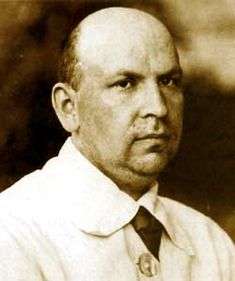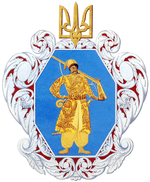Heorhiy Narbut
| Heorhiy Narbut | |
|---|---|
 | |
| Born | 1886 |
| Died | 1920 |
| Education | School of Simon Hollósy |
| Known for | Graphic design |

Heorhiy Narbut (Ukrainian: Георгій Іванович Нарбут, 25 February [O.S. 3 March] 1886 in Narbutivka — 23 May 1920 in Kiev) was the most important Ukrainian graphic designer of the twentieth century.[1]
He is known for designing the Coat of arms of Ukraine, banknotes, postage stamps, charters, and his many illustrations in books and magazines. He is also known as Georgy Narbut and George Narbut. He was a brother of a noted Russian Acmeist poet Vladimir Narbut.
Biography
Heorhiy Narbut was born in the village Narbutivka, Ukraine not far off from Hlukhiv. His family had origins of ancient Lithuanian nobility. His first painting education was self-taught.
Saint Petersburg
At about age 20, Narbut settled in Saint Petersburg from 1906 to 1917. There he studied with painters Ivan Bilibin and Mstislav Dobuzhinsky. In 1909, Narbut continued some of his studies in Munich, in the school of Simon Hollósy. After his return to Saint Petersburg he joined the organization Mir iskusstva. In 1910-1912 Narbut was an illustrator of the fairy tales Hans Christian Andersen, the fables of Ivan Krylov, and folk tales.
Kiev
In March 1917, Narbut moved to Kiev. In September 1917, he became professor and rector of the Ukrainian Academy of Arts. During this time he created his Ukrainian banknotes, postage stamps and charters for the newly created Ukrainian National Republic. Narbut also worked on the Ukrainian magazines: Nashe Mynule (Our past), Zori (Stars), and Sontse Truda (The Sun of Work) among others. He died of typhus in 1920.
The dancer Marina Berezowsky (1914-2011) was his daughter. She became a major figure in ballet in Australia.[2]
Works

- First definitive stamps of Ukraine (1992), after the drawing of Narbut
 Series from May 16, Michel catalog, #80
Series from May 16, Michel catalog, #80 Same Michel catalog, #81
Same Michel catalog, #81 Same Michel catalog, #79
Same Michel catalog, #79 Same Michel catalog, #82
Same Michel catalog, #82 Series from June 17 Michel catalog, #75
Series from June 17 Michel catalog, #75 Same Michel catalog, #76
Same Michel catalog, #76 Same Michel catalog, #77
Same Michel catalog, #77 Same Michel catalog, #78
Same Michel catalog, #78
| Wikimedia Commons has media related to Heorhiy Narbut. |
References
- ↑ Historical Dictionary of Ukraine p.125. June 15, 2014.
- ↑ Dally Messenger, "Great leader and teacher of dance", The Sydney Morning Herald, 13 July 2011. Retrieved 24 May 2016
External links
- 100 famous names of Ukraine - UKROP Encyclopedia (Ukrainian), Accessed 23 June 2008
- Heorhiy Narbut: founder of the Ukrainian graphics
- Heorhiy Narbut. Album. Kyiv,1983
- Heorhiy Narbut in Kharkiv Art Museum collection. Kharkiv, 1973.